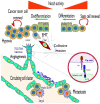Context Matters: NOTCH Signatures and Pathway in Cancer Progression and Metastasis
- PMID: 33430387
- PMCID: PMC7827494
- DOI: 10.3390/cells10010094
Context Matters: NOTCH Signatures and Pathway in Cancer Progression and Metastasis
Abstract
The Notch signaling pathway is a critical player in embryogenesis but also plays various roles in tumorigenesis, with both tumor suppressor and oncogenic activities. Mutations, deletions, amplifications, or over-expression of Notch receptors, ligands, and a growing list of downstream Notch-activated genes have by now been described for most human cancer types. Yet, it often remains unclear what may be the functional impact of these changes for tumor biology, initiation, and progression, for cancer therapy, and for personalized medicine. Emerging data indicate that Notch signaling can also contribute to increased aggressive properties such as invasion, tumor heterogeneity, angiogenesis, or tumor cell dormancy within solid cancer tissues; especially in epithelial cancers, which are in the center of this review. Notch further supports the "stemness" of cancer cells and helps define the stem cell niche for their long-term survival, by integrating the interaction between cancer cells and the cells of the tumor microenvironment (TME). The complexity of Notch crosstalk with other signaling pathways and its roles in cell fate and trans-differentiation processes such as epithelial-to-mesenchymal transition (EMT) point to this pathway as a decisive player that may tip the balance between tumor suppression and promotion, differentiation and invasion. Here we not only review the literature, but also explore genomic databases with a specific focus on Notch signatures, and how they relate to different stages in tumor development. Altered Notch signaling hereby plays a key role for tumor cell survival and coping with a broad spectrum of vital issues, contributing to failed therapies, poor patient outcome, and loss of lives.
Keywords: Notch signaling pathway; angiogenesis; epithelial-mesenchymal transition (EMT); gain and loss of function mutations (GOF and LOF); metastasis; oncogenic mutations; personalized cancer medicine; tumor microenvironment (TME); tumor progression; tumor suppressor gene.
Conflict of interest statement
The authors declare no conflict of interest.
Figures





References
Publication types
MeSH terms
Substances
LinkOut - more resources
Full Text Sources
Other Literature Sources
Medical

